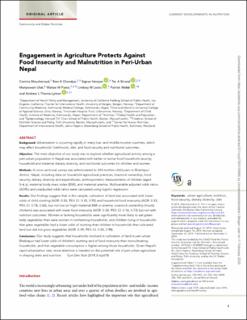| dc.contributor.author | Moucheraud, Corrina | |
| dc.contributor.author | Chandyo, Ram Krishna | |
| dc.contributor.author | Henjum, Sigrun | |
| dc.contributor.author | Strand, Tor A | |
| dc.contributor.author | Ulak, Manjeswori | |
| dc.contributor.author | Fawzi, Wafaie W. | |
| dc.contributor.author | Locks, Lindsey | |
| dc.contributor.author | Webb, Patrick | |
| dc.contributor.author | Thorne-Lyman, Andrew L. | |
| dc.date.accessioned | 2020-09-18T10:23:21Z | |
| dc.date.available | 2020-09-18T10:23:21Z | |
| dc.date.created | 2019-02-15T11:45:03Z | |
| dc.date.issued | 2019 | |
| dc.identifier.citation | Current Developments in Nutrition (CDN). 2019, 3 (1), 1-9. | en_US |
| dc.identifier.issn | 2475-2991 | |
| dc.identifier.uri | https://hdl.handle.net/11250/2678460 | |
| dc.description.abstract | Abstract Background Urbanization is occurring rapidly in many low- and middle-income countries, which may affect households’ livelihoods, diet, and food security and nutritional outcomes. Objective The main objective of our study was to explore whether agricultural activity among a peri-urban population in Nepal was associated with better or worse food household security, household and maternal dietary diversity, and nutritional outcomes for children and women. Methods A cross-sectional survey was administered to 344 mother–child pairs in Bhaktapur district, Nepal, including data on household agricultural practices, livestock ownership, food security, dietary diversity and expenditures, anthropometric measurements of children (aged 5–6 y), maternal body mass index (BMI), and maternal anemia. Multivariable adjusted odds ratios (AORs) and unadjusted odds ratios were calculated using logistic regression. Results Our findings suggest that in this sample, cultivation of land was associated with lower odds of child stunting (AOR: 0.55; 95% CI: 0.33, 0.93) and household food insecurity (AOR: 0.33; 95% CI: 0.18, 0.63), but not low (or high) maternal BMI or anemia. Livestock ownership (mostly chickens) was associated with lower food insecurity (AOR: 0.34; 95% CI: 0.16, 0.73) but not with nutrition outcomes. Women in farming households were significantly more likely to eat green leafy vegetables than were women in nonfarming households, and children living in households that grew vegetables had a lower odds of stunting than children in households that cultivated land but did not grow vegetables (AOR: 0.49; 95% CI: 0.25, 0.98). Conclusions Our study suggests that households involved in cultivation of land in peri-urban Bhaktapur had lower odds of children's stunting and of food insecurity than noncultivating households, and that vegetable consumption is higher among those households. Given Nepal's rapid urbanization rate, more attention is needed on the potential role of peri-urban agriculture in shaping diets and nutrition. | en_US |
| dc.description.sponsorship | This study was funded by the USAID Feed the Future
Security Innovation Lab for Nutrition—Asia (award
number AIDOAA-l-10-00005) through a subcontract
to the Harvard T.H. Chan School of Public Health and
the Johns Hopkins Bloomberg School of Public
Health from the Friedman School of Nutrition Science
and Policy, Tufts University; and by the GC Rieber
Foundation. | en_US |
| dc.language.iso | eng | en_US |
| dc.relation.uri | https://watermark.silverchair.com/nzy078.pdf?token=AQECAHi208BE49Ooan9kkhW_Ercy7Dm3ZL_9Cf3qfKAc485ysgAAAmowggJmBgkqhkiG9w0BBwagggJXMIICUwIBADCCAkwGCSqGSIb3DQEHATAeBglghkgBZQMEAS4wEQQMQ0m3t5BZcBZnKn_XA | |
| dc.rights | Navngivelse-Ikkekommersiell 4.0 Internasjonal | * |
| dc.rights.uri | http://creativecommons.org/licenses/by-nc/4.0/deed.no | * |
| dc.subject | urban food security, | en_US |
| dc.subject | nutrition, | en_US |
| dc.subject | agricultural practices, | en_US |
| dc.subject | food security | en_US |
| dc.subject | dietary quality | en_US |
| dc.subject | nutritional status, | en_US |
| dc.subject | households | en_US |
| dc.subject | Nepal | en_US |
| dc.subject | children’s nutritional status | en_US |
| dc.subject | engagement in urban agriculture | en_US |
| dc.subject | women’s dietary diversity | en_US |
| dc.subject | Household wealth | en_US |
| dc.subject | food and water | en_US |
| dc.subject | Women’s hemoglobin concentrations | en_US |
| dc.subject | anemia | en_US |
| dc.subject | maternal nutritional status | en_US |
| dc.subject | stunting | en_US |
| dc.subject | cultivation and vegetable production | en_US |
| dc.title | Engagement in agriculture protects against food insecurity and malnutrition in peri-urban Nepal | en_US |
| dc.type | Peer reviewed | en_US |
| dc.type | Journal article | en_US |
| dc.description.version | publishedVersion | en_US |
| dc.rights.holder | © 2018, Moucheraud et al. This is an open access
article distributed under the terms of the Creative
Commons Attribution Non-Commercial License
(http://creativecommons.org/licenses/by-nc/4.0/),
which permits non-commercial re-use, distribution,
and reproduction in any medium, provided the
original work is properly cited. | en_US |
| dc.source.pagenumber | 1-9 | en_US |
| dc.source.volume | 3 | en_US |
| dc.source.journal | Current Developments in Nutrition (CDN) | en_US |
| dc.source.issue | 1 | en_US |
| dc.identifier.doi | 10.1093/cdn/nzy078 | |
| dc.identifier.cristin | 1677628 | |
| cristin.ispublished | true | |
| cristin.fulltext | original | |
| cristin.qualitycode | 1 | |

